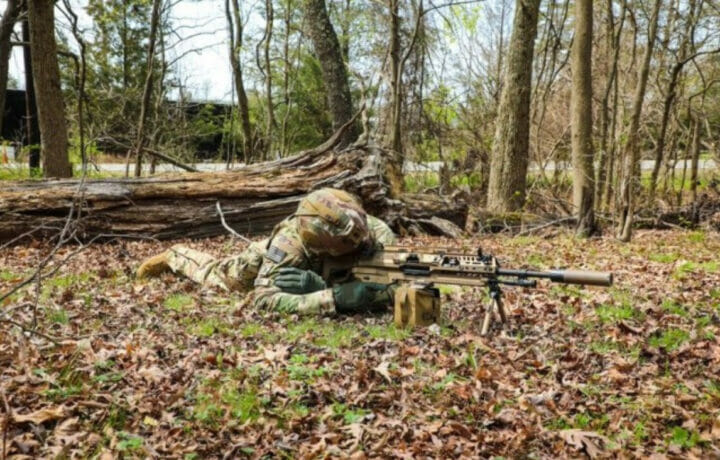Beginning early next year, some of America’s warfighters could be equipped with next generation firearms – and it will mark the beginning of the end of the M16 platform that first entered service with the U.S. military more than 50 years ago. The initial units of United States Army soldiers will receive the M5 rifle, as well as the M250 automatic rifle, which will replace the M4 Carbine and M249 light machine gun respectively.
It was back in April that the U.S. Army announced that it had selected Sig Sauer to produce the Next Generation Squad Weapons (NGSW) that will eventually replace the legacy firearms. It also marked the end of a rigorous 27-month prototyping and evaluation period, as the service awarded the Virginia-based gun maker a 10-year firm-fixed-price follow-on production contract to manufacture and deliver the two NGSW variants.
The Army’s NGSW prototyping and evaluation included technical tests and soldier touch points, and also considered competing prototypes from General Dynamics Ordnance and Textron Systems. The value of the initial delivery order for the contract was $20.4 million for weapons and ammunition that will undergo testing – while the current program value is slated at $4.7 billion for the weapon contract and another $2.7 billion for the associated NGSW-Fire Control, which was awarded to Vortex Optics and Sheltered Wings in early 2022.
It will also allow the Army to begin the transition that could see the eventual retirement of what have been the service’s two main firearms for decades. The M4, which was introduced in 1994, is essentially a shorter and lighter variant of the M16A2 assault rifle that dates back to the Vietnam War, while the M249 – formerly designated as a Squad Automatic Weapon – first entered service in 1984.
New Small Arms
The adoption of the new M5 and M250 is the first substantial change to U.S. military small arms since the adoption of the M16 in 1964. Unlike the M4 and M249, which were two different firearms, the M5 and M250 are essentially the same weapons – but in two different sizes to meet different needs on the battlefield. Both weapons will be chambered for the newly developed 6.8mm cartridge.
There are some notable tradeoffs.
The rifle version will include a number of features lacking in the current M4, including M-lock handguards, a Picatinny Rail, an ambidextrous safety, a left-side charging handle, and a collapsible buttstock. However, due to the larger size of the ammunition, M5 shooters will carry some 70 fewer rounds, while the rifle’s larger size, optics, and ammo load will add about five pounds.
In addition, M250 light machine gunners will have about 200 fewer rounds at their disposal, and that firearm will be about 3.6 pounds compared to an M249 loadout. Though the M250 is actually lighter, the ammunition is heavier and the new fire control adds about 2.6 pounds to the total package.
New Cartridge
Despite the increase in weight, the 6.8x43mm round is considered a fair tradeoff as it delivers greater lethality than the 5.56mm, while it has less recoil and weighs less than the 7.62mm cartridge. The round was developed by Remington Arms in collaboration with members of the United States Army Marksman Unit and the United States Special Operations Command to replace the 5.56 NATO cartridge.
The new round is based on the .30 Remington cartridge and is essentially “midway” between the 5.56x45mm NATO and the 7.62x51mm NATO in bore diameter. The 6.8mm round shares many attributes with the .270 caliber round commonly used in North American deer hunting, the Army Times reported.
In January, the Army awarded Winchester, the largest manufacturer of small-caliber ammunition for the U.S. military, a $20 million in cost-plus and firm-fixed-price contract to produce the 6.8mm ammunition for the NGSW.
Improved Optics
Both the M5 and M250 will be paired with the new M157 Fire Control, a ruggedized advanced fire control system that was developed to increase accuracy and lethality for the close combat force. It integrates several advanced technologies including a variable magnification optic (1X8), backup etched reticle, laser rangefinder, ballistic calculator, atmospheric sensor suite, compass, Intra-Soldier Wireless, visible and infrared aiming lasers, and a digital display overlay.
The M157 will be built by the Vortex Optics/Sheltered Wing partnership. The companies are scheduled to produce as many as 250,000 optics over the next 10 years at the Vortex facilities in Barneveld, Wisconsin.
The M5 and M250 are currently undergoing operational tests, and could start being fielded to Army units early next year. However, the M4 and M249 aren’t going away just yet. Both will remain in service with non-close combat soldiers for the foreseeable future.


